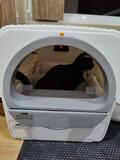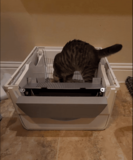If you think the litter box in the corner smells bad, imagine how much worse it is for your cat, whose nose is 14 times more sensitive than yours. While you can flush your toilet after use, your cat is stuck with the harsh, acidic smell of an uncleaned box. This can cause your cat to "act out" by finding a cleaner alternative, which neither of you will appreciate.
Maintaining a clean litter box not only improves your home's smell but also helps prevent common health issues such as urinary tract infections, ammonia-related respiratory irritation, and the spread of salmonella. If your cat holds it in due to a dirty box, they risk developing medical conditions like Feline Idiopathic Cystitis (FIC) and urinary blockages, which can cause pain and require veterinary visits and medication. While these conditions can arise even with a clean litter box, keeping it clean significantly reduces the risk.
Taking the time to maintain your cat’s litter box benefits both humans and pets. Even the most devoted cat owners might not know the best techniques and habits for keeping the litter box as clean as possible. The litter should be scooped daily and completely changed once a month, or twice a month in multi-cat households. Additionally, don’t forget to wipe down the litter box and remove any leftover litter.
Supplies for Cleaning a Litter Box:
- Replacement kitty litter
- Disposable gloves
- Garbage bag
- Cat litter scoop
- Disposable mask
- Unscented dish soap
- Paper towels, a scrub brush, or a scouring sponge
Step-by-Step Litter Box Cleaning Instructions
Empty the Litter Box
To achieve a spotless litter box, start by completely emptying it. It's advisable to wear a face mask and gloves for this task, as feline waste is acidic, may carry parasites and illnesses, and has a strong odor. Extra protection minimizes your risk of accidental exposure to your cat’s urine and feces.
Take the entire litter box outside and carefully empty its contents into a trash can. Pour slowly to prevent bacteria-laden dust from kicking back. If there are any remaining clumps of litter, use a broom to scrape them directly into the bin. A full litter box can be heavy, so it's essential to empty it outside to keep odors and dust from spreading inside your home.
Clean the Litter Box
Pour a few inches of hot water into the empty litter box and let it soak for a few minutes. Adding some unscented dish soap will help loosen any residual litter or waste, making it easier to scrub away problem spots with a scrub brush, sponge, or paper towels. Be sure to thoroughly clean all surfaces of the litter box, including the exterior sides and bottom, to prevent the spread of harmful bacteria in your home.
You can use your preferred mild, scent-free, and non-toxic cleaning product instead of dish soap. An unscented cleaner is crucial because house cats have a much sharper sense of smell than humans. Even mild citrus or pine scents can be overwhelming for your kitty and may discourage them from using the litter box.
Replace the Litter
Once the litter box is completely dry, carefully pour in fresh litter to avoid creating a dust cloud. Most cats thrive with two to three inches of litter, but if your cat has a habit of digging and kicking, consider using four to five inches to ensure there’s enough litter left after use. Make sure to level the litter, as cats prefer an even surface.
Each cat has unique preferences, so choose the right litter based on your pet's needs. For example, cats that tend to scatter litter outside the box might benefit from a low-tracking variety that clumps easily. Some pet owners prefer lightweight litter for easier handling or a dust-free option to reduce inhalation. Environmentally conscious cat lovers might opt for nontoxic, wood-based litter.
Maintain the Litter Box
To keep your cat’s litter box clean and fresh, establish a regular daily routine. Scoop out clumps of urine and feces at least once or twice a day, or more frequently if needed, to minimize odor and keep the litter box inviting.
Each time you scoop, you’ll remove some litter, so be sure to replenish it afterwards. Depending on the litter quality and the number of cats, replace the litter entirely every one to five weeks. Using a good clumping litter can help reduce waste when you clean the box daily.
How Often to Clean a Litter Box
To maintain a sanitary litter box and keep your cat happy, it's good practice to empty and thoroughly clean the litter box every other week. Use the cleaning steps detailed earlier. Daily scooping is crucial; aim to scoop at least once a day and remove feces promptly. This helps keep the litter smelling fresh and extends its usability.
Performing Daily Litter Box Maintenance
- Scoop Out Solid Waste:Remove poop once or twice a day to ensure a cleaner litter box and reduce the spread of odors and bacteria.
- Remove Urine Clumps:Run the scoop through the entire litter box to remove urine clumps. Using quality clumping litter makes it easier to remove these spots, reducing odor and conserving clean litter.
Performing Weekly Litter Box Maintenance
- Replace Litter More Frequently:Consider changing the litter completely once a week to every other week to keep it fresher longer.
- Clean the Box:Between litter changes, wash the litter box with soap and water to maintain a fresh-smelling area. Even if you opt for a three-week to monthly litter replacement, wiping down the interior and exterior of the box and cleaning the surrounding floor area after your daily scoop can minimize odors.
Quick Tips to Prevent Litter Box Problems
- Daily Scooping:Removing waste at least once a day significantly reduces persistent odors and encourages your cat to use the box.
- Avoid Flushing Litter:Never flush cat litter down the toilet, as it can cause severe plumbing issues.
- Use Clumping Litter for Multiple Cats:In households with multiple cats, clumping litter makes scooping extra waste easier.
- Specialty Boxes for Older Cats:Older or disabled cats may need a litter box with low sides to enter and exit easily without injury.
- Quiet, Accessible Location:Place the litter box in a quiet, accessible spot. In multi-story homes, consider having a litter box on each floor to prevent unwanted behavior.
- Kittens Will Outgrow Their Box:Remember, kittens grow quickly and will soon need a larger litter box. Ensure their box is appropriately sized.
By incorporating these tips and maintaining a regular cleaning schedule, you'll create a healthier, more pleasant environment for both you and your feline friend.
How to Clean a Litter Box While Pregnant
For pregnant cat owners, cleaning a litter box can pose significant risks. Toxoplasma gondii, a common feline parasite, can spread from cats to humans through contact with egg spores in cat feces. While it rarely causes illness in adults, it can lead to serious birth defects if a developing baby is infected. Indoor cats are less likely to contract this parasite than those that go outdoors.
According to the Centers for Disease Control and Prevention, pregnant people should avoid changing cat litter if possible. If no one else can do it, they should wear disposable gloves and wash their hands thoroughly with soap and water afterwards. It’s crucial to change the cat litter daily, as the Toxoplasma parasite does not become infectious until 1 to 5 days after being shed in cat feces.
Therefore, it is highly recommended that pregnant individuals avoid contact with the litter box or feline waste. The best solution is to have someone else in the household handle litter box duties. Pregnant cat owners should also consult their doctor to learn the safest ways to continue caring for their cat.
Conclusion
Everyone enjoys pampering their cats with toys, treats, and affection, but cleaning the litter box is rarely fun. By making it a habit to regularly scoop waste and thoroughly clean the litter box, the task becomes less unpleasant. More importantly, your cat will be happier and healthier, benefiting from the extra care you provide.
Frequently Asked Questions (FAQs)
How do I get rid of the cat litter smell in my house?
The strong odor of used cat litter can linger long after you've scooped and disposed of waste, but there are ways to minimize or eliminate the smell:
- Maintain a clean litter box.
- Consider changing your cat’s diet, as their current food might be causing odor issues.
- Use clumping litter to efficiently remove waste and reduce leftover smells.
- An air purifier can significantly help remove odors, especially models designed to tackle pet smells.
Can you put too much litter in a litter box?
Yes, but it depends on your cat’s behavior. Most cats are fine with two to five inches of litter, but some cats dig and kick excessively, causing a dusty mess. If your cat is a kicker, consider using a litter box with taller sides to contain the litter.
What happens if you don't clean the litter box daily?
Cat urine contains high levels of ammonia. If not cleaned daily, both you and your cat could suffer from coughing, lung irritation, and even pneumonia. Additionally, your cat’s feces can attract pests like flies and cockroaches if left too long. For everyone's health, maintain the litter box regularly.
What kills bacteria in a litter box?
Daily scooping helps reduce bacteria, but to truly kill bacteria, you need to scrub the entire litter box with dish soap during litter changes. Regular cleaning helps prevent bacteria from spreading to other parts of your home, such as cat beds and toys.
Can you sprinkle baking soda on cat litter?
Yes, sprinkling baking soda on the litter box walls and bottom before refilling helps freshen up the litter and makes it easier to remove clumps. Baking soda absorbs additional moisture and reduces odors effectively.









